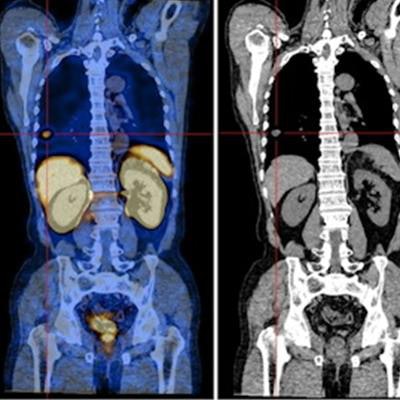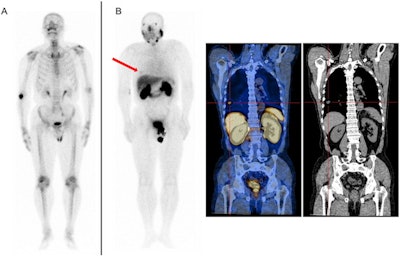
More metastatic bone tumors can be diagnosed in patients with prostate cancer using SPECT/CT with an experimental radiotracer over standard methods, according to a study by Chinese researchers published September 26 in Scientific Reports.
A group at Fujian Provincial Hospital in Fuzhou tested a new technetium 99m-labeled (Tc-99m) SPECT/CT radiotracer designed to reveal prostate-specific membrane antigen (PSMA) activity on cancer cells. Compared with SPECT/CT imaging with a standard Tc-99m methylene diphosphonate (MDP) radiotracer, the approach was significantly better at diagnosing bone lesions, they found.
"Tc-99m PSMA-SPECT/CT was superior to Tc-99m MDP SPECT/CT in the detection of bone metastases in [prostate cancer], especially for small lesions and in patients with low PSA levels," wrote corresponding author Dr. Wenxin Chen and colleagues.
Bone is the most common site for metastasis of prostate cancer, with skeletal-related tumors increasing the risk of death in patients by 28%. Due to this high rate, national and international treatment guidelines recommend bone imaging in these patients.
Bone imaging with Tc-99m MDP is the current gold standard in practice, yet it is limited in diagnosing visceral tumors that may develop earlier in the disease, such as in bone marrow, according to the authors.
PSMA is a highly overexpressed protein on the surface of cancer cells. In preclinical work, the group showed that a Tc-99m-labeled ligand (Tc-99m HYNIC-Glu-Urea-A) can effectively bind to prostate cancer cells, and thus reveal cancer on SPECT/CT imaging. In this study, the researchers aimed to assess how well the tracer works in patients, compared to Tc-99m MDP Only one similar prospective study in 41 patients has been published, the group noted.
Between October 2019 and November 2021, the researchers enrolled 74 men with pathologically confirmed prostate cancer. Participants had completed initial treatment, such as radical prostatectomy, and had biochemical recurrence, defined as a PSA level ≥ 0.2 ng/L.
All patients underwent both Tc-99m PSMA- and Tc-99m MDP-SPECT/CT at an average interval of 12.1 days. Bone lesions were scored as "typical metastasis" or "equivocal metastasis" by a standard reporting schema.
Among the 74 patients, 25 (33.8%) were diagnosed with bone metastasis, and 49 (66.2%) did not have bone metastasis, according to the findings. A total of 109 bone lesions were identified by Tc-99m PSMA, of which 105 were confirmed as bone metastases during follow-up. A total of 106 bone lesions were identified by Tc-99m MDP, of which 84 were confirmed as bone metastases during follow-up.
 A 66-year-old patient with biochemical recurrence of prostate cancer. The patient's Gleason score was 7, and the PSA level was 3.14 ng/mL. (A) Whole-body planar Tc-99m MDP. (B) Whole-body planar Tc-99m PSMA and coronal SPECT/CT. Tc-99m PSMA-SPECT/CT helped identify lung metastasis (B, red arrow and cross). Image courtesy of Scientific Reports.
A 66-year-old patient with biochemical recurrence of prostate cancer. The patient's Gleason score was 7, and the PSA level was 3.14 ng/mL. (A) Whole-body planar Tc-99m MDP. (B) Whole-body planar Tc-99m PSMA and coronal SPECT/CT. Tc-99m PSMA-SPECT/CT helped identify lung metastasis (B, red arrow and cross). Image courtesy of Scientific Reports.An analysis revealed a sensitivity and specificity of 80% and 100% for Tc-99m PSMA-SPECT/CT and 72% and 81.6% for Tc-99m MDP-SPECT/CT, the researchers wrote.
"Tc-99m PSMA scans clearly diagnosed the nature of the bone lesions, helping to reduce equivocal diagnoses, and demonstrated an additional benefit of providing information on extraskeletal metastases," the authors stated.
Ultimately, the approach leverages work in recent years showing that PET/CT imaging with gallium-68-labeled PSMA is among the most effective methods for identifying metastatic lesions in patients with prostate cancer, the authors wrote.
Yet PET/CT is not widely available in less developed countries, and far fewer institutions have PET/CT devices than SPECT/CT devices, they noted. Moreover, Tc-99m is inexpensive and more widely available, they added.
Additional research is warranted, the authors wrote.
"In the next stage, we plan to investigate the effects of different treatment responses on the detection efficiency of Tc-99m PSMA-SPECT/CT and Tc-99m MDP-SPECT/CT," Chen and colleagues concluded.





















